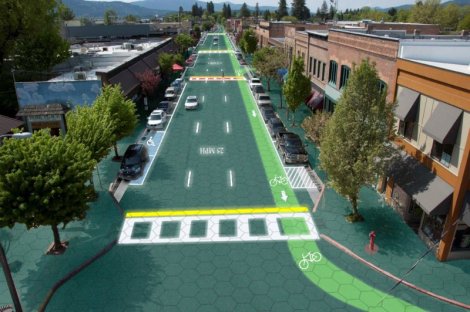Think Joni Mitchell would object to a parking lot paved with solar panels? They’re cute, impact-resistant, honeycomb-shaped ones, if that helps. Idaho couple Julie and Scott Brusaw want to cover roads across America with solar cells, so they started with the 12-by-36-foot driveway outside their office.

Solar RoadwaysArtist’s rendition of Sandpoint, Idaho.
Solar Roadways’ panels have heating elements to melt snow and ice, five-color LED lighting to create road lines, and corridors for moving and storing stormwater. The surface is made out of textured glass, which sounds pretty fragile, but apparently the panels can withstand 250,000 pounds.
The prototype shows dark blue solar cells on a green background; roughly 30 percent of the space is wasted. But in their Indiegogo campaign, Scott Brusaw says they’ve figured out a way to cover the entire hexagon with solar panels. Plus, each hexagon has a microprocessor — the makings of a smart road — and built-in power means overhead power lines aren’t necessary.
The Brusaws have taken to Indiegogo to raise a million bucks for production, now that R&D is finished. (They already received two rounds of funding from the U.S. Federal Highway Administration.) They’re trying to avoid investors or selling stock because they fear pressure to move manufacturing facilities overseas, rather than keeping the jobs in the U.S.
As for hard numbers, Wired writes:
There’s no word yet on how much the prototype installation cost — those numbers are being worked up and should be ready in July [along with the stats on how much energy the final panels will produce] — but the Brusaws say a commercialized solar roadway will provide enough power to pay for itself over its lifespan.
I guess if we can’t DANCE our way to electricity, solar roads are the next best thing.



